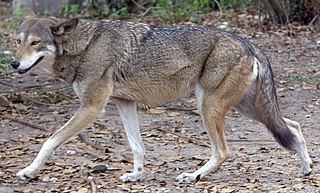
Canidae is a biological family of dog-like carnivorans, colloquially referred to as dogs, and constitutes a clade. A member of this family is also called a canid. The family includes three subfamilies: the Caninae, the extinct Borophaginae and Hesperocyoninae. The Caninae are known as canines, and include domestic dogs, wolves, coyotes, foxes, jackals and other species.

The red wolf is a canine native to the southeastern United States. Its size is intermediate between the coyote and gray wolf.

The eastern gray squirrel, also known, particularly outside of North America, as simply the grey squirrel, is a tree squirrel in the genus Sciurus. It is native to eastern North America, where it is the most prodigious and ecologically essential natural forest regenerator. Widely introduced to certain places around the world, the eastern gray squirrel in Europe, in particular, is regarded as an invasive species.

Asa Gray is considered the most important American botanist of the 19th century. His Darwiniana was considered an important explanation of how religion and science were not necessarily mutually exclusive. Gray was adamant that a genetic connection must exist between all members of a species. He was also strongly opposed to the ideas of hybridization within one generation and special creation in the sense of its not allowing for evolution. He was a strong supporter of Darwin, although Gray's theistic evolution was guided by a Creator.

The eastern wolf, also known as the timber wolf, Algonquin wolf and eastern timber wolf, is a canine of debated taxonomy native to the Great Lakes region and southeastern Canada. It is considered to be either a unique subspecies of gray wolf or red wolf or a separate species from both. Many studies have found the eastern wolf to be the product of ancient and recent genetic admixture between the gray wolf and the coyote, while other studies have found some or all populations of the eastern wolf, as well as coyotes, originally separated from a common ancestor with the wolf over 1 million years ago and that these populations of the eastern wolf may be the same species as or a closely related species to the red wolf of the Southeastern United States. Regardless of its status, it is regarded as unique and therefore worthy of conservation with Canada citing the population in eastern Canada as being the eastern wolf population subject to protection.

Grays Peak is the tenth-highest summit of the Rocky Mountains of North America and the U.S. state of Colorado. The prominent 14,278-foot (4352 m) fourteener is the highest summit of the Front Range and the highest point on the Continental Divide and the Continental Divide Trail in North America. Grays Peak is located in Arapahoe National Forest, 3.9 miles (6.2 km) southeast by east of Loveland Pass on the Continental Divide between Clear Creek and Summit counties. The peak is the highest point in both counties.

The gray fox, or grey fox, is an omnivorous mammal of the family Canidae, widespread throughout North America and Central America. This species and its only congener, the diminutive island fox of the California Channel Islands, are the only living members of the genus Urocyon, which is considered to be genetically basal to all other living canids. Its species name cinereoargenteus means "ashen silver".

Black squirrels are a melanistic subgroup of squirrels with black coloration on their fur. The phenomenon occurs with several species of squirrels, although it is most frequent with the eastern gray squirrel and the fox squirrel. Black morphs of the eastern gray and fox squirrels are the result of a variant pigment gene. Several theories have surfaced as to why the black morph occurs, with some suggesting that the black morph is a selective advantage for squirrels inhabiting the northern ranges of the species, with the black fur providing a thermal advantage over its non-melanistic counterpart.

Astereae is a tribe of plants in the family Asteraceae that includes annuals, biennials, perennials, subshrubs, shrubs, and trees. They are found primarily in temperate regions of the world. Plants within the tribe are present nearly worldwide divided into over 250 genera and more than 3,100 species, making it the second-largest tribe in the family behind Senecioneae.

Asaphocrita is a genus of moths in the family Blastobasidae.
Eupithecia irenica is a moth in the family Geometridae. It is found in South Africa.
Asaphocrita obsoletella is a moth in the family Blastobasidae which is endemic to Finland.

Asaphocrita aphidiella is a moth in the family Blastobasidae. It is found in North America, including British Columbia, Washington, California, Manitoba, Ontario, Quebec, Maine, New Hampshire and Ohio.
Asaphocrita busckiella is a moth in the family Blastobasidae. It is found in North America, including Maryland, Maine, New Brunswick, Ontario, Quebec and Tennessee.
Asaphocrita estriatella is a moth in the family Blastobasidae. It is found in North America, including Nova Scotia, Massachusetts and Maine.
Asaphocrita fuscopurpurella is a moth in the family Blastobasidae. It is found in the United States, including Maryland where the species was described from Plummers Island.
Asaphocrita plagiatella is a moth in the family Blastobasidae. It is found in the United States, including Arizona and Maine.
Asaphocrita plummerella is a moth in the family Blastobasidae. It is found in the United States, including Maryland, Tennessee and Maine.
Asaphocrita protypica is a moth in the family Blastobasidae. It is found in the United States, including Texas and New Mexico.
Asaphocrita sciaphilella is a moth in the family Blastobasidae. It is found in the United States, including Kentucky, Texas and California.









